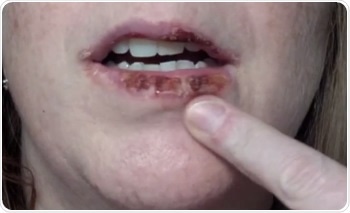By Jeyashree Sundaram (MBA)
Actinic cheilitis (AC) is condition that affects the vermilion border of the lower lip due to sun exposure It is characterized by dryness and thickening of lips. A complete cure from AC can be achieved only if manifestations are noted on time in addition to proper medication and treatment.

Actinic Cheilitis After Treatment
Surgical treatments like cryosurgery, vermilionectomy, and laser ablation therapy cause scars and wounds on lips. Healing of scars might take some time. Wounds produced by cryosurgery and laser therapy heal within a period of 7–14 days, while it takes two to four months for those caused by vermilionectomy. After the healing process, many patients experience good cosmetic results.
3% of patients who underwent surgical treatment had showed a recurrence of lesions with bleeding, ulceration, dryness, and palpable thickening of lips, which are indicative of lower lip malignancy. This might be due to either of the following:
- lack of early clinical diagnosis in chronic AC patients;
- difficulty in obtaining an accurate histopathological diagnosis.
However, with nonsurgical methods, approximately 10% of lesions in AC patients undergo malignant transformation. So, monitoring of lesions is essential.
Prognosis of Untreated Actinic Cheilitis – Mouth Cancer
Mouth (oral) cancer includes cancer related to lips and oral cavity. AC is a precancerous condition, but if proper treatment is not given on time, it could lead to cancers such as
- intraepidermal carcinoma (IEC) and
- invasive squamous cell carcinoma (SCC)
Initially, AC predisposes to IEC, which is also known as Bowen’s disease or SCC “in situ” (outer layer of the skin). IEC is considered as an early stage of invasive SCC. It is characterized by slow development of red, scaly lesions on the epidermal layer of lips. This type of cancer takes several years to grow as it slowly spreads cancer cells “in situ.” However, once the cancer cells invade the deeper layers, IEC transforms into invasive SCC.
Invasive SCC of the lower lip is a disease in which the cancer cells more aggressively affect the squamous cells of labial mucosa. It is commonly known as lip cancer. Metastasis (cancer cells capable of spreading to other parts of the body) rates of oral SCC are 14 times higher than that of SCC of skin.
90% of mouth cancers are due to SCC. A m ajority of mouth cancers were found in patients aged between 50 and 70 years, as this type of cancer develops slowly with age.
Lip cancer usually progresses as follows:
- development of a sore on the lip, which does not heal
- thickening of the lower lip with leukoplakia (white or red dapples) found on the lip lining
- bleeding, ulceration, pain, and numbness of the recurring lesion in the lips of AC patients
Generally, SCC of the lips is more prone to metastasis. For example, the cancer cells in the lower lip are capable of spreading to adjacent areas such as buccal region and lymph nodes of the neck. But some studies have reported that lip malignancies connected with AC showed a lower occurrence of metastasis. T his indicates that lip malignancies arising from AC have better prognosis.
Progression of Actinic Cheilitis to Oral SCC
The cell proliferation regulatory proteins in addition to tumor suppressor genes play a vital role in the progression of AC to SCC.
When exposed to sunlight, nucleic acids of the lower lip absorb ultraviolet (UV) radiation. T his prevents the replication of DNA, causing decreased photoprotective capacity of the lower lips. In addition, the UV radiation alters the natural immunologic functions, which help respond to tumor cells.
Impairment of apoptosis (programmed cell death) induction is the earliest stage of SCC development, since it allows the cancer cells to survive and presents them with a chance to multiply. Researchers have discovered that in the premalignant as well as malignant lesions, most of the regulatory pathways of apoptosis are mutated.
Through immunohistochemical methods, it has been informed that the epithelial expression of p53 and murine double minute (mdm2) regulatory genes are increased in AC patients. T he change in the expression pathway of genes like p53, mdm2, and p21 is a common characteristic of oral SCC.
The following factors predict the progress of AC to SCC of lips:
- p53 and mdm2 levels
- impairment in the relationship between cell proliferation
Sources
- Actinic cheilitis and squamous cell carcinoma of the lip: clinical, histopathological and immunogenetic aspects, https://www.ncbi.nlm.nih.gov/pubmed/22481658
- Immunohistochemical expression of matrix metalloproteinase‐1, matrix metalloproteinase‐2 and matrix metalloproteinase‐9, myofibroblasts and Ki‐67 in actinic cheilitis and lip squamous cell carcinoma, https://www.ncbi.nlm.nih.gov/pmc/articles/PMC4693555/
- Precancerous lesions of oral mucosa, https://www.ncbi.nlm.nih.gov/pmc/articles/PMC4266835/
- Squamous cell carcinoma of the lip, https://www.ncbi.nlm.nih.gov/pubmed/3685181
- A Case of Metastatic Squamous Cell Carcinoma Arising from Actinic Cheilitis, https://www.ncbi.nlm.nih.gov/pmc/articles/PMC3119986/
- National Cancer Institute, https://www.cancer.gov/types/head-and-neck/patient/lip-mouth-treatment-pdq
- UTHealth, https://med.uth.edu/orl/newsletter/lip-cancer/
Further Reading
- All Actinic Cheilitis Content
- Actinic Cheilitis Prevention
- Actinic Cheilitis – Symptoms and Causes
- Actinic Cheilitis Diagnosis and Treatment
- Actinic Cheilitis (AC)
Last Updated: Feb 26, 2019
Source: Read Full Article
